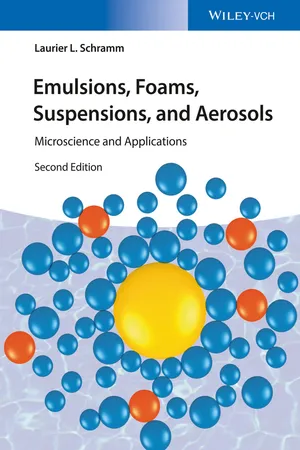1.1 From the Colloidal State to Nanotechnology
A colloidal dispersion comprises a collection of small particles, droplets or bubbles of one phase, having at least one dimension between about 1 and 1000 nm, and dispersed in a second phase. Either or both phases may be in gas, liquid, solid or supercritical phase states. Matter of colloidal size, just above atomic dimensions and overlapping with the emerging regime of nanotechnology, exhibits physicochemical properties that differ from those of the constituent atoms or molecules yet are also different from macroscopic material. Colloidal materials have also been referred to as ultra-divided matter [1].
The atoms and molecules of classical chemistry are extremely small, usually having molar masses less than 1000 g mol−1 and measurable by freezing point depression. Macroscopic particles fall into the realm of classical physics and can be understood in terms of physical mechanics. Residing between these extremes is the colloidal size range of particles whose small sizes and high surface area to volume ratios make the properties of their surfaces very important and lead to some unique physical properties. Their solutions may have undetectable freezing point depressions, and their dispersions, even if very dilute, may sediment out very slowly, in apparent violation of Stokes' law (see Section 2.4.1). Although the particles of classical chemistry may have one or a few electrical charges, colloidal particles may carry thousands of charges. With such strong electrical forces, complete dissociation is the rule for colloidal species, rather than the exception. In addition, the electric fields can strongly influence the actions of neighbouring species.
The earlier definition of colloidal species encompasses not only particles, droplets and bubbles but also thin films on large surfaces (e.g. antiglare coatings on glasses) and thin liquid films such as foam films (separating two vapour phases), emulsion films (separating two droplets), suspension films (separating two solid surfaces) and wetting films (separating a solid or liquid from a vapour). For colloidal species the specific surface areas (surface area per unit mass) are relatively large, therefore the properties of the interfaces can have an important influence on their properties. For this reason, colloid chemistry and interface chemistry are usually treated as a single scientific discipline.
Systems containing colloidal-sized particles, droplets or bubbles are important because they feature prominently in both desirable and undesirable contexts; in a wide variety of practical disciplines, products and industrial processes; and in everyday life. The problems associated with colloids and interfaces are usually interdisciplinary in nature and a broad scientific base is required to understand them completely. For this reason, the term colloid and interface science is often used in modern writing.
The field began to acquire its own identity when Graham coined the term colloid in 1861 [2–4]. Since that time, the language of colloid science has evolved considerably [5–8] and makes two principal distinctions: lyophobic (thermodynamically unstable) and lyophilic (thermodynamically stable) colloidal dispersions. If the dispersion medium is aqueous, then the terms hydrophobic and hydrophilic, respectively, are used. Lyophilic colloids are formed spontaneously when the two phases are brought together because the dispersion is thermodynamically more stable than the original separated state. The term lyophilic is less frequently used in modern practice because many of the dispersions that were once thought of as lyophilic are now recognized as single-phase systems in which large molecules are dissolved. Lyophobic colloids are not formed spontaneously on contact of the phases because they are thermodynamically unstable compared with that of the separated states. These dispersions can be formed with mechanical energy input via some form of agitation such as that provided by a propeller style mixer, a colloid mill or an ultrasound generator. The resulting suspension may have considerable stability as a metastable dispersion. Examples of lyophobic colloidal dispersions are emulsions, foams, suspensions and aerosols, and these form the main subjects of this book. Examples of lyophilic colloidal dispersions are surfactant micelles, protein solutions and viruses. These will be dealt with as well in this book, but in less detail.
In modern practise the terms lyophilic and lyophobic (especially hydrophilic and hydrophobic) are often used to characterize surfaces in addition to colloidal dispersions. This sometimes leads to confusing usage. For example, a clay dispersion in water could be classified as a lyophobic colloid with hydrophilic surfaces.
Simple colloidal dispersions are two-phase systems, comprising a dispersed phase of s...
